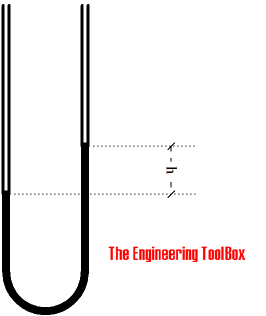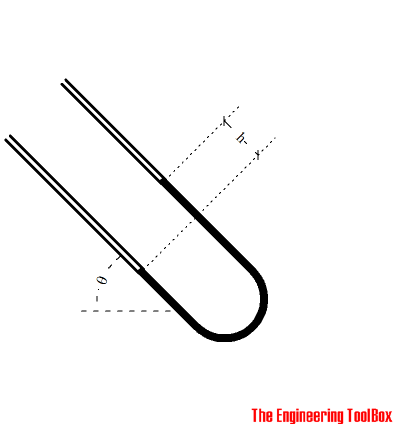
Pressure measuring devices using liquid columns in vertical or inclined tubes are called manometers. One of the most common is the water filled u-tube manometer used to measure pressure difference in pitot or orifices located in the airflow in air handling or ventilation system.
In the figure bellow illustrates the water levels in an u-tube where the left tube is connected to a point with higher pressure than the right tube - example: the left tube may be connected to a pressurized air duct when the right tube is open to the ambient air.

The pressure difference measured by a vertical U-Tube manometer can be calculated as
p d = γ h
= ρ g h (1)
where
p d = pressure (Pa, N/m 2 , lb/ft 2 )
γ = ρ g = specific weight of liquid in the tube (kN/m 3 , lb/ft 3 )
ρ = U-tube liquid density (kg/m 3 , lb/ft 3 )
g = acceleration of gravity (9.81 m/s 2 , 32.174 ft/s 2 )
h = liquid height (m fluid column, ft fluid column)
The specific weight of water , which is the most commonly used fluid in u-tube manometers, is 9.81 kN/m 3 or 62.4 lb/ft 3 .
Note! - the head unit is with reference to the density of the flowing fluid. For other units and reference liquid - like mm Water Column - check Velocity Pressure Head .
A water manometer connects the upstream and downstream pressure of an orifice located in an air flow. The difference height in the water column is 10 mm .
The pressure difference head can calculated from (1) as
p d = (9.8 kN/m 3 ) (10 3 N/kN) (10 mm) (10 -3 m/mm)
= 98 (N/m 2 , Pa)
where
9.8 (kN/m 3 ) is the specific weight of water in SI-units.
A common problem when measuring the pressure difference in low velocity systems - or systems with low density fluids - like air ventilation systems - are low column heights and accuracy. Accuracy can be improved by inclining the u-tube manometer.
The figure bellow indicates a u-tube where the left tube is connected to a higher pressure than the right tube. Note that the left and the right tube must in the same declined plane for the angle to the horizontal plane to be correct.

The pressure difference in a inclined u-tube manometer can be expressed as
p d = γ h sin(θ) (2)
where
h = length, difference in position of the liquid column along the tube (mm, ft)
θ = angle of column relative the horizontal plane (degrees)
Inclining the tube manometer increases the accuracy of the measurement.
We use the same data as in the example above, except that the U-Tube is inclined 45 o .
The pressure difference head can then be expressed as:
p d = (9.8 kN/m 3 ) (10 3 N/kN) (10 mm) (10 -3 m/mm) sin(45 o )
= 69.3 N/m 2 (Pa)
This calculator can be used to calculate the differential pressure measured with an U-tube manometer.
γ - specific weight of the fluid in the tube (kN/m 3 , lb/ft 3 )
(9.8 kN/m 3 , 62.4 lb/ft 3 default values for water)
h - length of the liquid column along the tube (mm, ft)
θ - angle of column relative the horizontal plane (degrees)